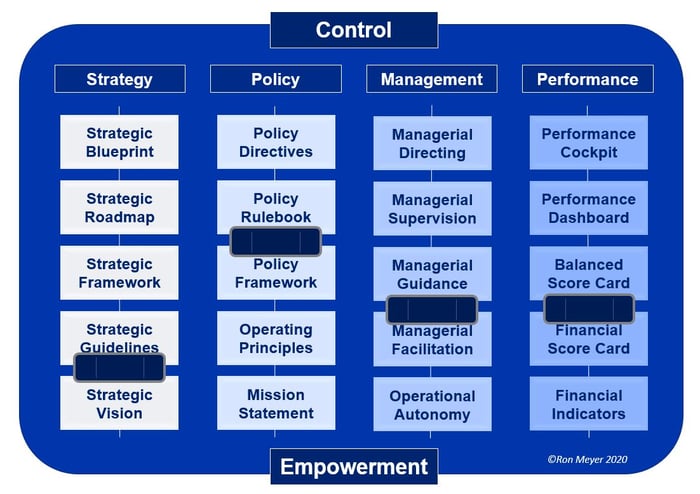How can I control what people in my organization do?

To be in control is to have the ability to steer the organization in any desired direction. The controls are the specific mechanisms used to do the steering. Some controls are formally assigned to certain people (hard controls), while other controls can be informally acquired over time by personal effort (soft controls).
Controls give someone power over others, reducing the others’ autonomy to do as they see fit. In other words, the more control, the less others are empowered to steer themselves. This tension between steering and self-steering is called the paradox of control and empowerment.
Conceptual model
The Control Panel summarizes the four main hard controls available to managers to steer the behavior of others. For each of these levers of control, the model suggests that a manager can decide how much control to exert, somewhere along a continuum between high control and high empowerment. All four controls have been brought together in one control panel to visualize that managers need to take an integrated view of how they use their hard controls, as the people being controlled will feel the cumulative pressure of all four slides impinging on their autonomy to make their own decisions.
Key elements
The four slides of the Control Panel can be found on the following dimensions:
1. Strategy
Control can be exerted by determining the strategy that needs to be followed. This strategy can range from very broad (high empowerment) to very specific (high control):- vision. Only giving a rough sketch of a desired long-term future.
- Strategic guidelines. Offering general strategic principles to give people guidance.
- Strategic framework. Determining a broad outline of objectives and initiatives.
- Strategic roadmap. Specifying a general plan with targets, actions and roles.
- Strategic blueprint. Imposing a comprehensive plan detailing almost all activities.
2. Policy
Control can also be exerted by establishing the policies to which people must comply. These rules of engagement can again range from very broad to very specific:- Mission statement. Only outlining the organizational purpose, values and beliefs.
- Operating principles. Setting general ground rules to give people guidance.
- Policy framework. Stipulating an organizational constitution for all to live by.
- Policy rulebook. Spelling out regulations to which people need to adhere.
- Policy directives. Laying down detailed protocols for people to strictly follow.
3. Management
While control can be exerted ahead of time by setting strategy and/or policy, control can also be maintained in real time by direct managerial intervention:- Operational autonomy. Deciding to fully empower and not intervene at all.
- Managerial facilitation. Indirectly steering by creating helpful conditions.
- Managerial guidance. Giving occasional coaching, feedback and suggestions.
- Managerial supervision. Determining which activities to do and following progress.
- Managerial directing. Instructing what needs to be done and how.
4. Performance
Control can also be exerted by setting performance objectives and checking whether they have been met. The key performance indicators employed can differ widely:- Financial indicators. Only setting a few financial targets to be reached.
- Financial scorecard. Outlining a broader range of financial indicators to be met.
- Balanced scorecard. Defining key indicators in a number of core areas.
- Performance dashboard. Establishing key indicators for all activities.
- Performance cockpit. Detailing extensive indicators for all activities.
Key Insights
- Fair and fear as the two approaches to leadership. Leadership is the ability to influence others to move in a certain direction, and there are two types of influence; being fair builds trust and sways people to follow voluntarily, while fear triggers people to follow compliantly.
- Fairness is the high road to leadership. Acting fairly is a key ingredient of building trust between the leader and the followers. It generally takes long and requires considerable effort, but it is the route to winning hearts and minds and achieving lasting engagement.
- Three types of fairness. Leaders can be fair in the way they relate to others (fair attitude), in the way they deal with others (fair process) and in the way they share results with others (fair outcomes). The three forms are complementary and can reinforce each other.
- Fairness is in the eye of the beholder. While leaders might think they are behaving fairly, the only thing that matters to have influence is how the follower experiences a leader’s behavior. Therefore, leaders need to ensure that they are seen to be fair.
- Fear also works. But there is also a low road to leadership, which plays on fear to get people to comply. This approach works and is used by many, both intentionally and inadvertently. It is up to each leader to consciously choose which road they wish to take.
This blog is part of a series, if you want to see all the blogs, then click below:





